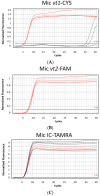Development and Validation of the MAST ISOPLEX®VTEC Kit for Simultaneous Detection of Shiga Toxin/Verotoxin 1 and 2 (stx1/vt1 and stx2/vt2) with Inhibition Control (IC) in a Rapid Loop-Mediated Isothermal Amplification (LAMP) Multiplex Assay
- PMID: 39337553
- PMCID: PMC11432264
- DOI: 10.3390/ijms251810067
Development and Validation of the MAST ISOPLEX®VTEC Kit for Simultaneous Detection of Shiga Toxin/Verotoxin 1 and 2 (stx1/vt1 and stx2/vt2) with Inhibition Control (IC) in a Rapid Loop-Mediated Isothermal Amplification (LAMP) Multiplex Assay
Abstract
Loop-mediated isothermal amplification (LAMP) is a cost-effective, rapid, and highly specific method of replicating nucleic acids. Adding multiple targets into a single LAMP assay to create a multiplex format is highly desirable for clinical applications but has been challenging due to a need to develop specific detection techniques and strict primer design criteria. This study describes the evaluation of a rapid triplex LAMP assay, MAST ISOPLEX®VTEC, for the simultaneous detection of Shiga toxin/verotoxin 1 and 2 (stx1/vt1 and stx2/vt2) genes in verotoxigenic Escherichia coli (E. coli) (VTEC) isolates with inhibition control (IC) synthetic DNA using a single fluorophore-oligonucleotide probe, MAST ISOPLEX®Probes, integrated into the primer set of each target. MAST ISOPLEX®Probes used in the MAST ISOPLEX®VTEC kit produce fluorescent signals as they integrate with reaction products specific to each target, allowing tracking of multiple amplifications in real time using a real-time analyzer. Initial validation on DNA extracts from fecal cultures and synthetic DNA sequences (gBlocks) showed that the MAST ISOPLEX®VTEC kit provides a method for sensitive simultaneous triplex detection in a single assay with a limit of detection (LOD) of less than 100 target copies/assay and 96% and 100% sensitivity and specificity, respectively.
Keywords: DNA/LYO3; MAST ISOPLEX® VTEC; POC; loop-mediated isothermal amplification; lyophilization; multiplex.
Conflict of interest statement
Author Matthew Bennett was employed by the company Mast Group Ltd. The remaining authors declare that the research was conducted in the absence of any commercial or financial relationships that could be construed as potential conflicts of interest.
Figures




Similar articles
-
Development of a multiplex loop-mediated isothermal amplification assay to detect shiga toxin-producing Escherichia coli in cattle.J Vet Sci. 2014;15(2):317-25. doi: 10.4142/jvs.2014.15.2.317. Epub 2014 Mar 21. J Vet Sci. 2014. PMID: 24675834 Free PMC article.
-
Rapid and visual detection of Shiga-toxigenic Escherichia coli (STEC) in carabeef meat harnessing loop-mediated isothermal amplification (LAMP).Braz J Microbiol. 2024 Jun;55(2):1723-1733. doi: 10.1007/s42770-024-01335-9. Epub 2024 Apr 19. Braz J Microbiol. 2024. PMID: 38639846 Free PMC article.
-
A rapid on-site loop-mediated isothermal amplification technology as an early warning system for the detection of Shiga toxin-producing Escherichia coli in water.Microbiology (Reading). 2024 Aug;170(8):001485. doi: 10.1099/mic.0.001485. Microbiology (Reading). 2024. PMID: 39109421 Free PMC article.
-
Multiplex real-time PCR assay for detection of Escherichia coli O157:H7 and screening for non-O157 Shiga toxin-producing E. coli.BMC Microbiol. 2017 Nov 9;17(1):215. doi: 10.1186/s12866-017-1123-2. BMC Microbiol. 2017. PMID: 29121863 Free PMC article.
-
Applications of DNA probes for Vero cytotoxin-producing Escherichia coli.J Hosp Infect. 1991 Jun;18 Suppl A:438-42. doi: 10.1016/0195-6701(91)90054-c. J Hosp Infect. 1991. PMID: 1679813 Review.
References
Publication types
MeSH terms
Substances
Supplementary concepts
LinkOut - more resources
Full Text Sources
Molecular Biology Databases

